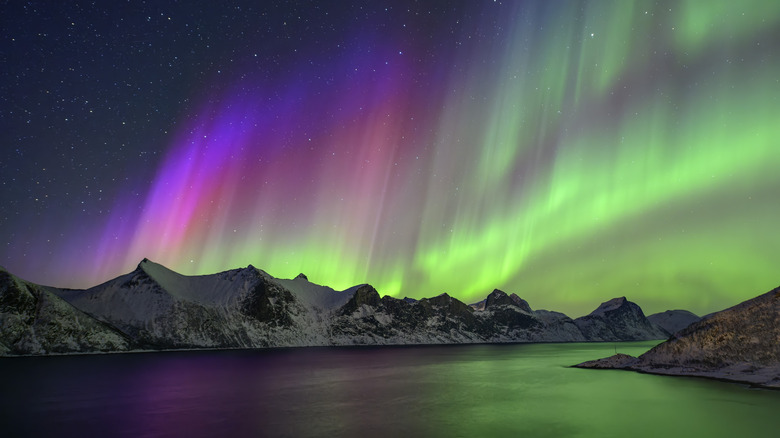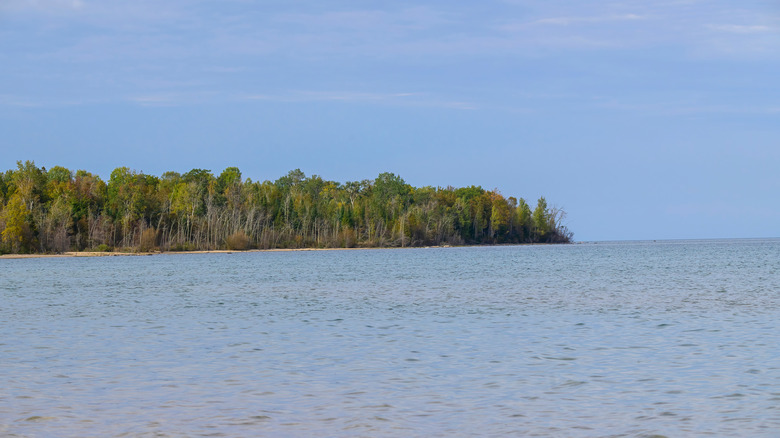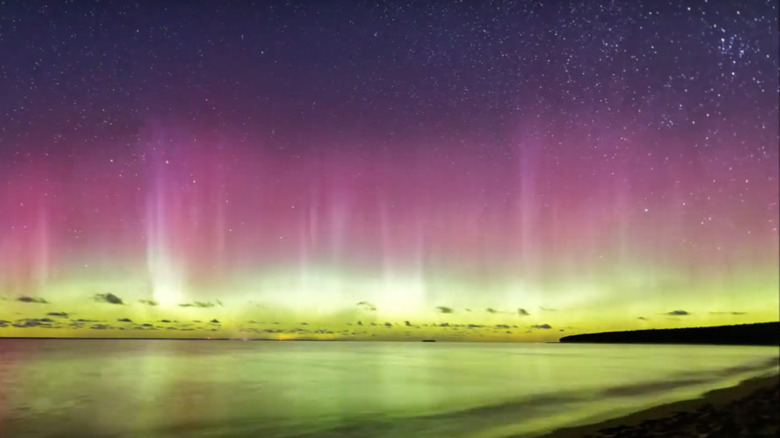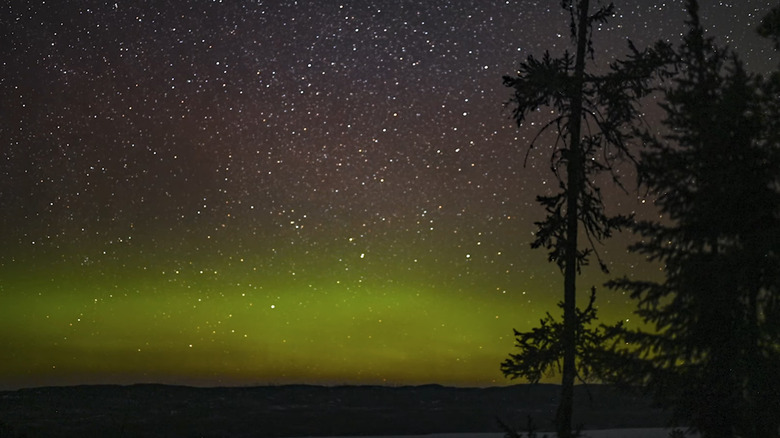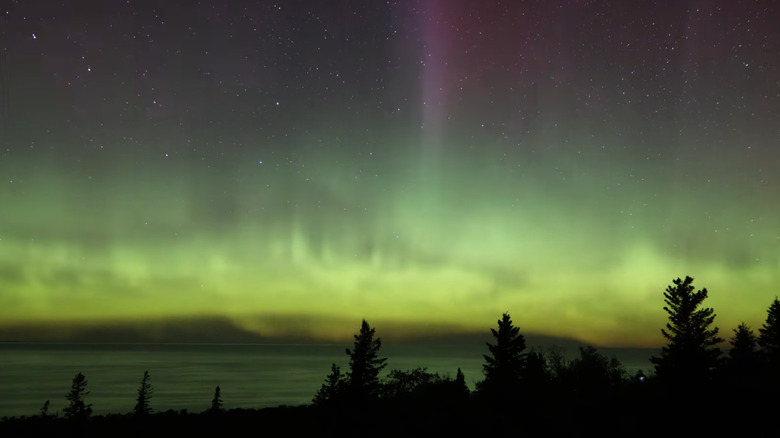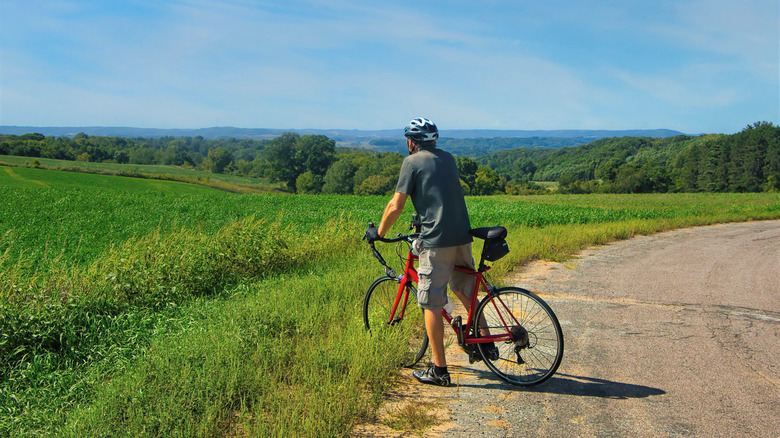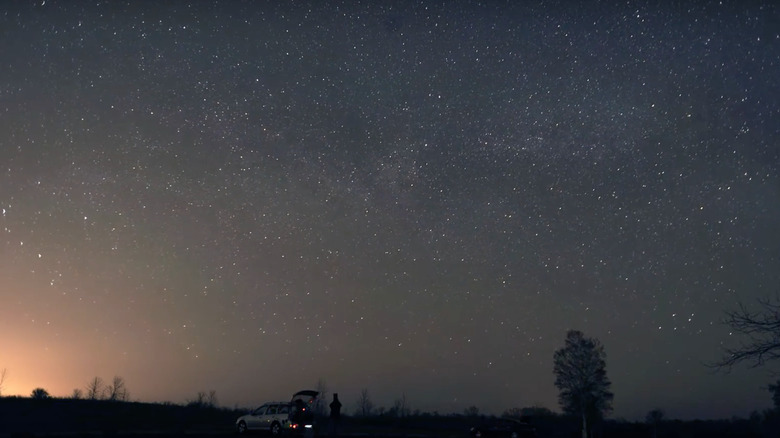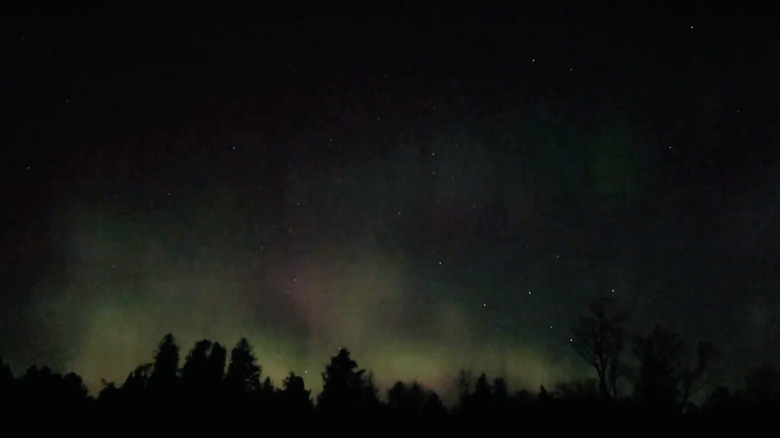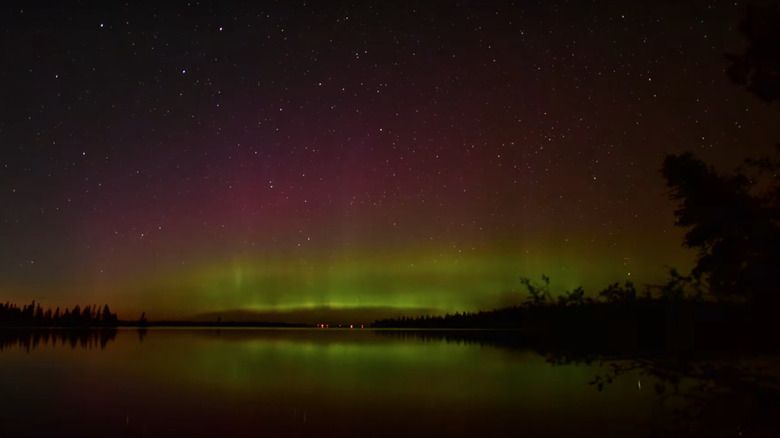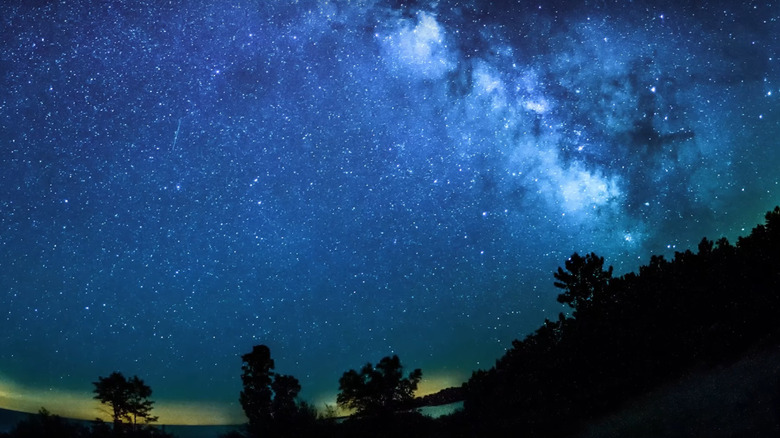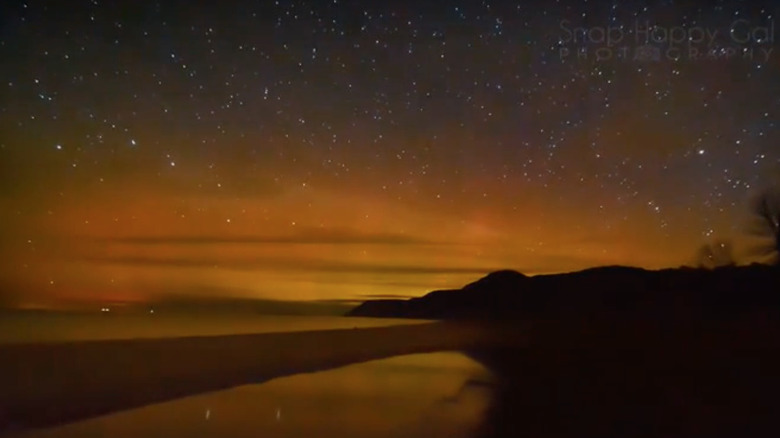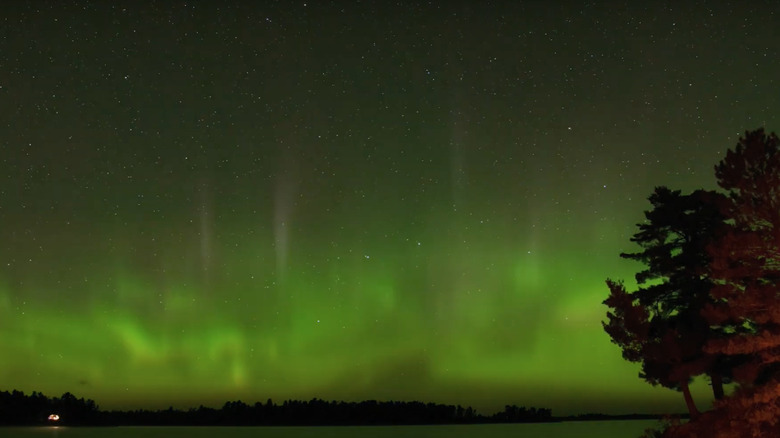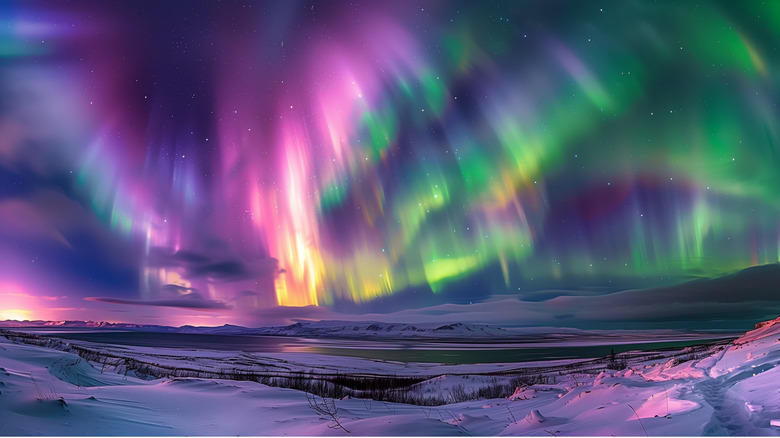The Best Midwest Destinations Where You're More Likely To Spot Northern Lights
Officially known as the aurora borealis, the Northern Lights are a light show unlike anything else on the planet. Created by the action of particles from the sun as they speed their way into Earth's atmosphere, the lights paint the sky with vivid, trippy colors that almost defy belief. Imagine wild green, purples, and red that tint the night with a ghostly glow, otherworldly hues on a canvas usually notable for its darkness. Since the particles are shunted toward the two poles, the crazy light show appears at the Earth's extremities. This means that the light patterns are also visible in the south of the planet — these are known as the Southern Lights — but for residents of the U.S., the Northern Lights are the only ones that can be seen.
While you will need a combination of factors to ensure the lights are shining, it is a regular happening in America. So, for lucky residents far enough north, the good news is that they don't have to travel to the traditional hotspots, like Iceland or Scandinavia, to witness the phenomenon. (A Swedish national park is one of the best destinations in the world to see the Northern Lights). Across the northern band of the Lower 48, and in Alaska, there are places where travelers can marvel at this vibrant natural occurrence. There are also a number of spots in the Midwest, where large, open expanses with little light pollution allow the colors to shine. We picked through blogs to find the best of them.
Alpena, Michigan
About 10,000 people live in this lakeside town that sits in the northern part of the Lower Peninsula. For such a small hamlet, however, Alpena boasts a wealth of places to see the Northern Lights. There are three parks near the town that are designated as dark sky preserves, where the deep absence of light makes them perfect for seeing the Northern Lights.
It was in early 2016 when Negwegon State Park, Rockport State Recreation Area, and Thompson's Harbor State Park were given the title of Michigan Dark Sky Preserves. In practical terms, this means that artificial lighting in each of the three is minimal thanks to their distance from any sizable towns or developments. Negwegon State Park, for instance, sits alongside Lake Huron and has almost 10 miles of waterfront, including some beaches. Seeing the lights reflecting over the lake's waters is a mesmerizing site that visitors are unlikely to forget.
Apostle Islands National Lakeshore, Wisconsin
Part of the remit of the National Park Service, this area of marine splendor resides at the end of Bayfield Peninsula. It comprises more than 20 islands as well as some mainland coastline along Lake Superior and features beaches, many lighthouses, and even some sea caves. For kayakers, adventures await at this Midwest National Park. Travelers will experience a feeling of remoteness here, and that certainly assists visitors in finding spots around the park to marvel at the spectacle, of which there are many.
At Little Sand Bay, skywatchers might detect a hint of light from Minnesotan land to the north, but this is likely to be minimal. From here, travelers will have clear vistas to the north and west, and they can head down to the dunes on the beach to look out over the water. This site is on the mainland. On the islands, the sky is likely to appear even more clearly. Outer Island 1 has a sand spit at its southern cusp. Standing near the end of it, you'll be able to see the sky all around you without any interference.
Boundary Waters Canoe Area Wilderness, Minnesota
Geologists might be quick to point out that the terrain and waters of this wilderness area were shaped by the slow, steady, irresistible work of glaciers. As glaciers progressed and retreated, they cut cliffs into the rocks, carved out sinewy canyons, and sculpted sections of soaring rock. They also left in their wake streams, lakes, beaches, and coastal areas punctuated by rock. It's a beautiful part of the country, spreading across one million acres of territory, some of it along the border with Canada.
For water adventurers, this is a dream come to life, with more than 1,000 miles of waterways that can be navigated on a kayak or canoe within the confines of the area. Take a trip there and you are likely to spot tons of wildlife. For something a little different, consider seeing the Northern Lights here while joining a multi-night tour to watch the stars and the night sky. Piragis offers a guided canoe trip that combines travel on a canoe, sleeping in campsites (there are more than 2,000 of them in the wilderness area), and peering up at the Northern Lights (hopefully) in awe as a guide details what you are looking at.
Brockway Mountain, Michigan
To get to this part of Michigan, travelers need to get way out there, almost to the end of the Keweenaw Peninsula, southeast of Isle Royale. The beauty of this scenic drive is its elevation, rising high above the fray. Named for a pioneering settler in the area, the Brockway Mountain Drive extends for about nine miles and leads from Copper Harbor to the top of Brockway Mountain. Not only is it a gorgeous drive, but it's also a key environment for migrating birds — winged wonders that descend on the mountain from April to June.
The vistas of Lake Superior and the Keweenaw Peninsula are spellbinding, which shouldn't come as a surprise since this is the highest-elevation paved road between the Alleghenies and the Rockies. There are many stopping points along the drive, and for night sky watchers, this is where you'll want to scope out a spot. The sky is so clear and the lake so expansive and flat 735 feet below the drive's endpoint, that the Northern Lights will come alive. And the views from the top unfurl across 360 degrees, so you'll never have to worry about not facing the right direction. With the combination of height and the lake below, the lights can look as though they are being beamed from another planet.
Driftless, Illinois/Iowa/Minnesota/Wisconsin
Driftless is a great place for seeing night skies. This region spreads across multiple states and takes in spots like Prairie du Chien, Soldiers Grove, Viola, and Genoa in the Wisconsin portion. In all, Driftless encompasses more than 24,000 square miles of land and water, and its name derives from the geology behind its shape.
The topography of karst rock and waterways flanked by steep walls of limestone is due to the absence of the drift from glacial activity (hence driftless), a process that typically leaves behind gravel and silt. And within that impressive form, visitors will find many places to see the Northern Lights. Travelers will see the ghoulish lights more clearly when high up, on the side of a mountain or a ridge. The Lower Wisconsin Riverway is a good choice thanks to its low light pollution, as is the Kickapoo Valley Reserve.
Harrington Beach State Park, Wisconsin
This isn't a huge park by any stretch of the imagination, and yet it provides a fantastic location in the Midwest for viewing the Northern Lights. The park features some beachfront right on Lake Michigan, and within its 715 acres, visitors will encounter a cedar swamp, wetlands, and even an old limestone quarry that has filled with water to become a lake. There are public astronomy meetings each month in the park's observatory, and inquisitive visitors can show up to peer at the illuminated night sky.
When a light storm brightens the darkness, travelers will be able to find a spot on the beach and look north. Thanks to the consummate dark in the park at night, the colors of the Northern Lights really come to life. Even better is the effect of them reflecting off the waters of Lake Michigan. Another interesting aspect of a visit there is that a shipwreck sits offshore — the steamboat "Niagra" was built in 1845, but sank in 1856 after a fire broke out onboard.
Headlands International Dark Sky Park, Michigan
The designation of a place as a Dark Sky Park means that it uses lighting that doesn't overly impact the natural order of darkness, and it offers programs where visitors can celebrate the joys of a truly dark sky. This park, which sits on McGulpin Point west of Mackinaw City, ensures that guests can immerse themselves in darkness once night falls. While the Northern Lights are never a sure thing, with no fixed schedule or dependable seasonal occurrence, when they do appear, this park gets very busy. Not only do the particles have to hit the Earth's atmosphere to create the lurid hues, but the skies also need to be clear of clouds, which also can't be guaranteed.
While the viewing area in the park doesn't face due north, it will allow travelers the chance to see the lights over the waters of Lake Michigan. And if the lights are really strong — again, something can't be predicted — the nearby Mackinac Bridge might be another spot worth checking out. The Northern Lights draped in the night sky with the lit bridge below is an unforgettable image.
Isle Royale National Park, Michigan
On a map, this national park looks like a piece of jagged bark floating in a sea of blue (though it's actually in Lake Superior). This is a supremely wild place, remotely located and very close to the border with Canada, a popular destination for outdoor adventurers in search of hiking, diving, camping, and kayaking. You can also escape it all at this remote national park. That sense of separation from land and urban existence helps this to be a great spot for night watching. That said, the park is only open seasonally, from mid-April through to Halloween.
This is because, for the rest of the year, the conditions are harsh, and unpleasant for a leisure visit. Since the park actually consists of a number of islands, and even channels of water within each island, the chance to see the Northern Lights in the sky and also mirroring off the water is easy to attain. With no harsh exterior lighting, very limited facilities, and plenty of open space, this park presents an ideal option in the Midwest.
Newport State Park, Wisconsin
This park resides in Door County, the Midwest's most underrated vacation spot. It was afforded Dark Sky Park status in 2017, so light pollution will not be a concern for travelers who prize extremely dark nights, or even those who like to immerse themselves in the pitch black. The park spreads across more than 2,300 acres of Door Peninsula, a tapered finger of land that reaches 70 miles into Lake Michigan. Around the park, travelers can expect to see dense forests of hardwood and evergreen trees, wetlands, a handsome network of hiking routes, and 11 miles of waterfront, where the park meets the lake.
Thanks to its position near the end of the peninsula, and the distance that it sits away from the mainland of Wisconsin (and any sizable population base), the park revels in its isolation and blissful darkness. The facilities are so minimal that visitors will only find camping for backpackers, a park office, simple picnic areas, and little else. What this means is that the Northern Lights, especially when seen projected above the waters of Lake Michigan, won't be obstructed by anything of note.
Sleeping Bear Dunes National Lakeshore, Michigan
Another slash of wilderness that is part of the National Park Service, this area has, as the name suggests, plenty of dunes. There are also long ribbons of sandy beachfront and bluffs that extend out into Lake Michigan as they rise more than 400 feet above the water. It is the towering dunes that make this park such a magnetic attraction, and when standing atop one, visitors can enjoy long views across the lake that seem to never end.
To the west of the park, there is nothing but water all the way to Wisconsin (Door Peninsula, in fact). While facing north, travelers can make out the form of the Manitou Islands. Far beyond those isles stands the Upper Peninsula. Since the park has more than 60 miles of waterfront right on Lake Michigan and very little ambient light, it supplies a smart location for watching the Northern Lights. Better yet, the lights look extra pretty when reflected on the still surface of the lake.
Theodore Roosevelt National Park, North Dakota
In the west of the state, near the border with Montana, this national park is many miles from a large city, so artificial light sources are in short supply. That's a boon for avid night-sky watchers, like those who might congregate on a cloudless evening when the Northern Lights appear. Making the experience even more gratifying is that the air quality in this piece of Midwestern wilderness is exceptional. According to a study published in 2009 by the National Park Service, the air at the park is among the best in the whole National Park Service system.
On a normal night, you can peer through that air to see stars, constellations, and the glinting astronomical haze that we call the Milky Way. Some nights, meteor showers bring brilliant activity to the dark sky. The park has large open expanses of land, as well as colorful buttes, canyons, and rock formations, making it a perfect spot to see broad areas of night sky. That's what makes the park such a good option for watching the aurora borealis. While some areas outside the park are used for oil and gas extraction, guests can avoid the lights from these industries by choosing a location away from these operations.
Voyageurs National Park, Minnesota
In the north of the state, this park encompasses more than 200,000 acres of space. It features not only open areas with land and lakes, but also forests, streams, and channels that are fun to explore in a kayak. The underrated waterfront national park was officially launched in 1975 and takes its name from the French-Canadian Voyagers who used to ply the waters in search of business. The mixture of water and land makes Voyageurs National Park a fine option for seeing the Aurora Borealis.
The shimmering lights, whose name derives from the Latin words for "sunrise" (aurora) and "to the north" (borealis), display a hauntingly hypnotic quality when they glimmer off the waters. The park is far north enough to fall in the typical catchment area of the lights, and winter is the best time to see them due to longer. Among the best locations to see the night sky are the Meadowood Road Day Use Area, and the higher parking area at the Rainy Lake Visitor Center. Any area within a lake, or next to one and facing north, is also a clever choice.
Methodology
Some consider the Midwest the true heart of America. Whether you espouse that view or not, one thing that is for sure is that this part of the U.S. has a lot of land. And, some parts of it are sparsely populated. North Dakota, for instance, has less than 800,000 people living in the whole state. The upshot of large areas of land and low population density means lots of open, natural space that doesn't experience interference from light pollution. For fans of the night sky, or even casual observers who occasionally marvel at what else is out there in the universe, this is a huge bonus.
While stargazing in the Midwest is good at any time of the year, seeing the Northern Lights in the region is extra special. Many locations stand out as great choices to see the Aurora Borealis in the Midwest. To find the best of them, we sifted through blogs like The Wander Club, and MidwestLiving to narrow down the more deserving options. We also consulted pages like DarkSiteFinder to zone in on areas in the Midwest that have really dark skies. After all, the darker and clearer the night, the more sensational the colors will appear—both in person and when you post them to make your family and friends insanely jealous.
